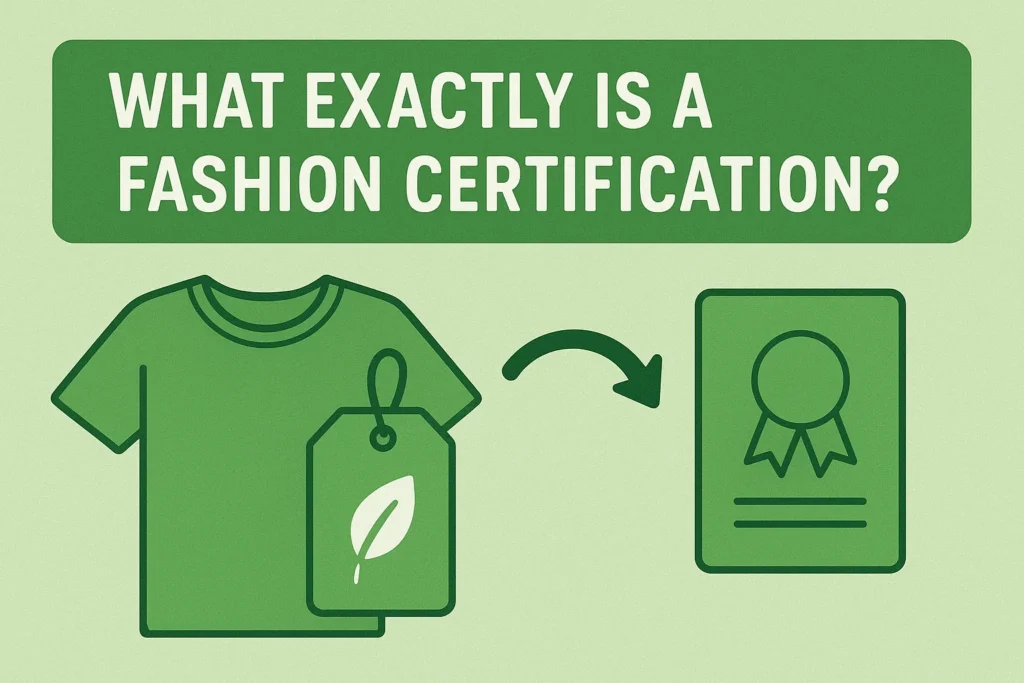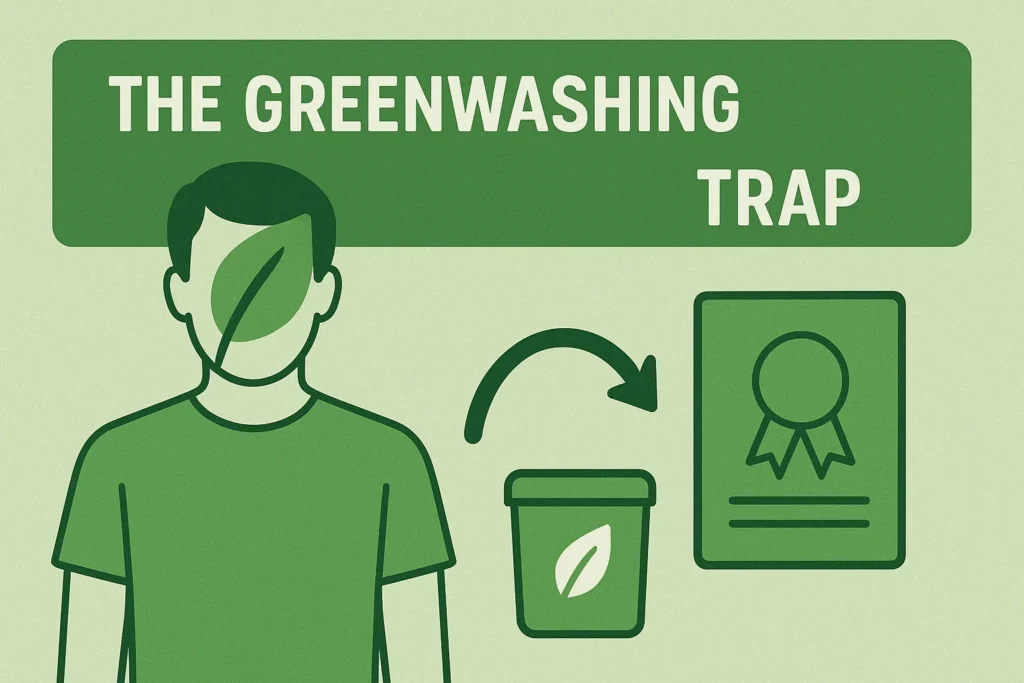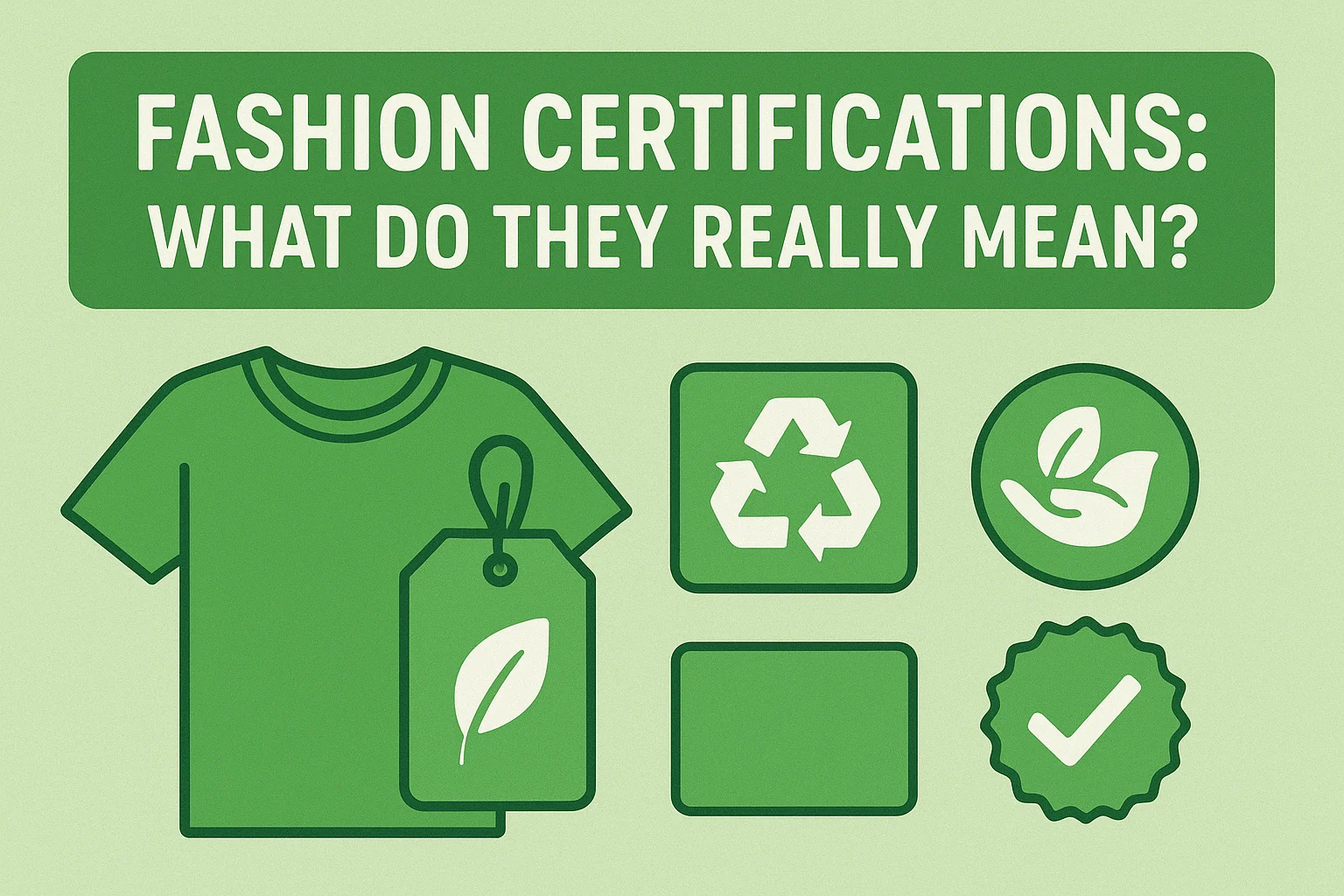You’re browsing in a store, your hand brushing over cotton shirts, wool sweaters, and silky dresses. Then you spot it—a small, neat label with an eco logo. It feels like a seal of approval. The brand wants you to believe this piece is good for the planet, good for workers, and good for you.
But here’s the twist: some certifications are genuine passports of trust… and others are about as trustworthy as a “self-proclaimed world’s best coffee” sign in a diner.
In this guide, we’ll pull back the curtain on fashion certifications—what they really mean, the ones worth trusting, and the ones that are little more than marketing theatre. Along the way, we’ll show you how Eco Gear Guides helps cut through the noise.
What Exactly is a Fashion Certification?

Think of a fashion certification as an official report card for your clothes. It’s proof that a garment, material, or production process has met specific, measurable standards set by an independent body—not just the brand itself.
They generally focus on three big areas:
- Environmental Impact – minimizing waste, pollution, and resource use.
- Human Rights – ensuring workers earn fair wages and work in safe conditions.
- Consumer Safety – making sure your clothing is free from harmful substances.
Example: In 2024, a small South Korean outerwear brand saw sales skyrocket after earning the Bluesign® certification—opening export markets that had been out of reach for years.
The Certifications That Carry Real Weight
There are dozens of certifications floating around in the fashion space—but only a few have the credibility and auditing power to back their claims.
| Certification | Focus Area | Why It Stands Out | Real Example |
|---|---|---|---|
| GOTS (Global Organic Textile Standard) | Organic textiles | Tracks every stage from farm to factory; strict chemical bans | People Tree |
| Fair Trade Certified | Labor rights | Funds community projects; audits wages annually | TenTree |
| OEKO-TEX Standard 100 | Consumer safety | Tests for over 350 toxic substances | Boody |
| Bluesign® | Manufacturing | Controls energy, water, and chemical waste | Kathmandu |
| GRS (Global Recycled Standard) | Recycled content | Verifies recycled material & ethical supply chains | Girlfriend Collective |
| SA8000 | Social accountability | Based on UN human rights conventions | Eileen Fisher |
Beyond the Obvious – Lesser-Known But Powerful Labels
Most blogs stop at GOTS or Fair Trade, but there are other gems:
- Cradle to Cradle Certified™ – Assesses products for their entire lifecycle, from design to recyclability.
- Nordic Swan Ecolabel – Scandinavian standard that limits energy use in production.
- EU Ecolabel – Focuses on minimizing water and air pollution in textile manufacturing.
A Tale of Two Hoodies
Let’s play this out in real life.
Hoodie A (Certified)
- Made from 85% GOTS-certified organic cotton.
- Sewn in a Fair Trade factory in India.
- Dyed with Bluesign-approved low-impact dyes.
Hoodie B (Non-Certified)
- Cotton farmed with heavy pesticide use.
- Sewn in a factory with no independent labor oversight.
- Dyed using chemicals that can contaminate waterways.
At first glance, they look almost identical. But Hoodie A carries a traceable, verifiable story—Hoodie B carries risks you’ll never see on the price tag.
The Greenwashing Trap

Some brands create in-house eco badges with no audits or independent checks. These fake labels are designed to trick your brain into believing a product is sustainable.
Signs it’s greenwashing:
- No mention of the certification body or audit process.
- Vague language like “eco-friendly” without specifics.
- Certifications you can’t verify on an official website.
Industry example: In 2023, a global retailer was forced to remove over 1,200 products labeled “sustainable” after regulators found zero evidence of independent verification.
Read More : How to Build a Capsule Wardrobe Sustainably
Why Certifications Often Mean Longer-Lasting Clothes
While the main purpose of certifications is ethics and safety, they often indirectly lead to better quality because:
- Certified materials are better regulated for durability.
- Processes avoid harsh chemicals that weaken fibers.
- Brands seeking certification often invest in superior stitching and finishing.
Where to Find Certified Fashion Without the Guesswork
Doing all the research yourself is exhausting. That’s why platforms like Eco Gear Guides handpick brands that meet genuine certification standards—covering everything from PETA-approved vegan shoes to GRS-certified recycled outerwear.
Conclusion – More Than Just a Logo
A certification isn’t a magic wand—it won’t turn fast fashion into slow fashion overnight. But when used correctly, it’s a shortcut to trust.
Knowing what each label means helps you:
- Avoid empty marketing claims.
- Support ethical labor and sustainable production.
- Spend money in alignment with your values.
When you see that little eco-label, ask: Who certified it? How is it verified? What does it guarantee?—because that’s when a label stops being just a sticker and starts being a statement.
Read More : How to Care for Clothes Sustainably
FAQs About Fashion Certifications
Q1: Can a single item have multiple certifications?
Yes—especially if it meets standards in different categories like material sourcing and labor rights.
Q2: Which is the best starting point for beginners?
GOTS for organic textiles, Fair Trade for labor ethics, and OEKO-TEX for skin safety.
Q3: Are there fake certifications?
Yes—always check the certifier’s official site for verification.
Q4: Do certifications expire?
Most require renewal every 1–3 years with follow-up audits.
Q5: Are uncertified clothes always unethical?
Not always, but without independent proof, you have to take the brand’s word for it.


